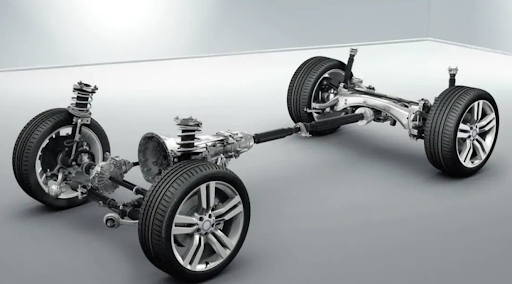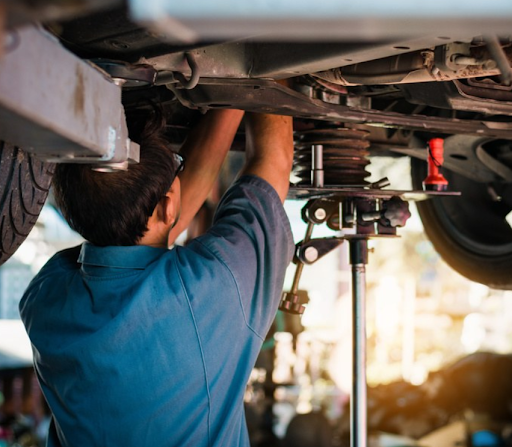8 minute read
While engines and sheer horsepower are what get cars going, for a tolerable ride and decent handling on different roads, the suspension plays a pivotal role. This is a collection of various parts that connects the wheels and the car frame and ensures speed bumps, potholes and road irregularities don’t get through to the cabin. Your vehicle’s suspension additionally keeps the tires glued to the road, thus ensuring stability and safety.
Suspension Basics
In simple terms, the suspension is a collection of parts that cushion the forces acting on the tires and wheels when vehicles encounter road imperfections. Without car suspension parts, drivers and passengers will feel every imperfection as it transfers into the cabin and through the seats. This is what is defined as ride quality, or simply, comfort. But besides dealing with rocks, potholes, road debris or speed bumps, the suspension additionally keeps the wheels and tires firmly on the ground. It provides maximum traction, allowing the vehicle to accelerate, brake and negotiate turns. Without these components, driving is impossible.
How It Works
Auto suspension parts work by dissipating external forces that vehicles encounter during changes to road surfaces. These forces are converted to heat before they can reach the cabin. The main purpose is road isolation, or absorbing shocks and vibrations and preventing them from causing discomfort. The parts smooth out rough road sections, while keeping the vehicle at a level height.
Road holding, or keeping wheels in contact with the road at all times, is the other role suspension parts play. They prevent the car from experiencing excess sway and body roll when accelerating, braking or cornering, by evenly distributing weight across all wheels. Different setups and suspension types do this in various ways.
Common Parts
To get a better understanding of how suspension works, let’s take a closer look at the individual car suspension parts and their role in taming road irregularities and resulting harshness and vibrations.
Springs
The main job of suspension springs is to compress or extend while keeping the chassis level. By doing this, they keep wheels and tires in contact with the road surface. On smooth roads, they are compressed, and they store energy released while encountering bumps, obstacles or potholes.
Coil springs are the most common in passenger cars and are preferred for their low weight, simple designs, and high comfort levels. Leaf springs are older designs, comprised of layered metal bars placed one atop the other. They can handle higher-weight loadings, so they are more common in heavier commercial vehicles or at the rear axle of light trucks.
Torsion bars consist of a spring steel element attached to the frame and another end to a wishbone, acting as a lever and moving perpendicular to the bar. The torsion bar twists along its axis to provide a spring force. Lastly, there are air springs. These are recent additions to cars (though they have been used for military purposes for ages) and consist of reinforced rubber filled with compressed air. They’re now seen in luxury cars, with the technology slowly becoming accessible as an aftermarket addition.
Shock Absorbers
These suspension parts contain the energy of springs as they extend and compress. Shock absorbers, or dampeners, are aptly named and dampen movement in the springs and provide more control. They do this by turning vibrations into heat, which is then dissipated through hydraulic fluid. The parts consist of a gas or fluid-filled encased metal reservoir, with the upper mount connected to the car frame, and the other connected to the axle near the wheel. The upper mount is also connected to a perforated piston, encased in a tube filled with fluid or gas.
There are two basic variations to this design: monotube and twin-tube shocks. Monotubes have a single tube with a floating piston separating the gas and hydraulic fluid chambers. The separate gas chamber provides an expansion area for excess fluid to move during compression. The design ensures better control over the springs, specifically at higher speeds and on rougher roads.
Twin tubes have two cylinders, one inside the casing and the other housing the piston. The design is tuned for comfort. Being more common, it is also cheaper to purchase.
Struts and Anti-Roll Bars
Struts are shock absorbers mounted inside coil springs. They differ from a separate shock and spring assembly in that they are also structural elements supporting the weight of the vehicle.
Anti-roll or sway bars prevent body roll in corners. They are metal rods, with a left and right roll bar at each axle. When vehicles encounter bumps, potholes, etc., the bars transfer energy to the opposing wheel, keeping the vehicle stable.
Suspension Types
There are three main types of suspension – independent, dependent and semi-independent.
Independent
Independent suspension consists of car suspension parts that allow each wheel to react independently to road imperfections and transfer less motion to other wheels, thereby preventing handling issues. By limiting vibrations, the setup additionally improves ride quality and comfort. Other advantages include limited wear to connecting suspension elements, lower tyre wear and more leeway for customizing the suspension to road specifics.
A common type of independent suspension is the MacPherson strut, often seen on the front axle of front-wheel drive passenger cars. The layout is simple, lightweight and reliable. Similarly, double-wishbone setups, use two wishbone or control arms, mounted between the wheel knuckle and chassis.
Both upper and lower arms have ball joints to allow movement in multiple directions. The design allows for minor adjustments to parameters that affect ride and handling, such as camber and caster angles in wheel placement, so is tuned for performance and luxury vehicles. Lastly, multilink suspension is a complex independent suspension type, comprising (as the name implies) up to 6 separate control arms. The purpose is to limit wheel movement by providing more control and maximizing tire traction.
Although the various independent suspension types are more intricate and have more parts, the higher cost is more than offset by better handling, significantly improved comfort, and less wear and damage to related parts, such as tires, wheels, or steering components.
Dependent
These usually consist of a solid axle or beam connecting both wheels. The simple design is commonplace in older vehicles and the rear axles of cheaper cars. The advantages are lower production and maintenance costs and higher durability.
The downsides, though, are the main reason vehicle manufacturers are turning to other solutions. One major issue is limited wheel articulation, with both wheels affected by irregularities in road surfaces, transferring more vibrations and harshness inside. And with both the right and left wheels affected, there can be uneven and pronounced tire wear.
Semi-Independent
These are hybrid setups, containing elements of independent and dependent suspension. For economy cars, a typical setup is usually a MacPherson strut up front, and a solid beam at the rear. The layout reduces overall vehicle costs but still retains most of the positives of both suspension types. In compact passenger cars (in front-wheel drive layouts), there are fewer components without significantly compromising handling or comfort. The solid beam reduces maintenance costs while being durable and capable of handling more weight.
Signs of Suspension Problems
Smoothing out road bumps, and keeping wheels and tires on the road can be tasking on multiple parts in any suspension setup. Problems can appear in old and new vehicles, regardless of mileage. Where and how you drive, how the car has been maintained, and parts with poor build or incorrect installation can all play a part. Regular issues include:
- Pulling to the left or right – this can be due to damaged joints, bearings, springs, control arms or struts. The same symptoms arise from uneven tire wear, misaligned wheels and steering issues. If these are sorted, have the suspension inspected.
- Excessive vibrations and harshness – problems with the shocks or struts lead to pronounced bouncing, meaning even the smallest bumps reach the cabin. Cars with shocks should be checked for fluid leaks, and those with struts for knocking sounds when driving over bumps.
- Tilting – one corner of the vehicle sitting lower often points to damaged springs. Check for knocking or creaking sounds by pushing on the rear axle or boot. And ensure this is not due to flat or near-flat tires.
- Diving and squatting – the suspension balances the front and rear of the car, even on harder acceleration or braking. Excessive diving when hitting the brakes, or rear squat when on the gas is a sign of shock or strut issues. The same parts can cause the car to roll more than usual in corners.
- Difficulty steering – the steering and suspension are connected, so issues with any car suspension components can lead to tougher steering. A common problem here is wearing control arms. Related damage to steering parts includes low power steering fluid levels and a faulty pump.
If you notice one or more symptoms, have the car inspected. Driving with faulty suspension can be dangerous. Source quality OE or aftermarket parts from specialist suspension brands, or consider upgrades (coilovers, performance springs, air suspension systems, anti-roll bars and strut tower braces) if you want to improve ride quality and handling.






